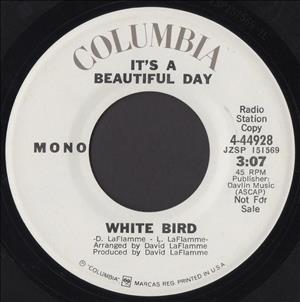On October 4, 1969, the song "White Bird" makes its debut on Billboard magazine's best-seller charts -- the beginning of a four-week run that peaks at the No. 118 slot. That relatively lowly chart position belies the actual nature of the tune's popularity and impact: due to the song's length (6:06) and the band's unwieldy name (It's a Beautiful Day) and unusual instrumentation (an absolutely searing five-string electric violin), AM radio shuns the song and only the more freeform "underground" FM stations embrace "White Bird." And thus it is that the song, written during the band's sojourn in Seattle in the winter of 1967-1968, will take wings and become a hippie-era FM radio classic.
Mansion as "Woodshed"
It's a Beautiful Day was formed in San Francisco in 1967 by its classically trained leader, David LaFlamme (violin), and his wife, Linda LaFlamme (organ) along with Pattie Santos (vocals), Hal Wagenet (guitar), Mitchell Holman (bass), and Val Fuentes (drums). Before long, the group's manager, the controversial Matthew Katz (who had already mucked-up the business affairs of Jefferson Airplane and Moby Grape), persuaded them to relocate to Seattle, where they could woodshed awhile without the glare of media attention then being focused on their California peers.
Although they were initially reluctant to go, Katz also offered the bandmembers living quarters in his five-story Capitol Hill mansion at 1429 E Prospect Street, and a string of gigs at his San Francisco Sound dancehall based in Seattle's historic Encore Ballroom (1214 E. Pike Street). The group arrived in Seattle in December 1967 and -- with a short-term local singer, Carol Suffron (ex-Seattle's Canterbury Tales band) -- began daily rehearsals at the hall and two-shows-per-night weekend dances that featured psychedelic light shows by Don Paulson's Lux Sit & Dance company. Those practice sessions would ultimately produce the songs that would constitute the band's first LP -- including David and Linda Laflamme's most beloved composition: "White Bird."
A Winter's Day in the Rain
And true to form for many musicians in the Northwest, the dark and damp weather also served as an inspiration, of sorts, for this visiting band's creative muse. According to David Laflamme's recollections:
"We were living in the attic of an old Victorian house in Seattle, and performing at the Encore Ballroom. It was a typical Seattle winter day, rainy and drizzly, and we were looking out from the attic window over the street in front of this old house. It was on Capitol Hill, the old section of town across from Volunteer Park ...
"The song describes the picture Linda and I saw as we looked out this little window in this attic. We had a little Wurlitzer portable piano sitting right in the well of this window, and I'd sit and work on songs. When you hear lines like, '... the leaves blow across the long black road to the darkened sky and its rage ...,' it's describing what I was seeing out the window.
"Where the 'white bird' thing came from: We were like caged birds in that attic. We had no money, no transportation, the weather was miserable. We were just barely getting by on a very small food allowance provided to us. It was quite an experience, but it was very creative in a way" (David "White Bird" LaFlamme website).
A Hot Summer Day
In 1968 Laflamme's crew headed back to California where, on October 4, they lucked into their first big break: Cream was in the midst of a Farewell Tour, accompanied by Traffic, when that opening act's singer, Stevie Winwood, fell ill and concert promoter Bill Graham contacted It's a Beautiful Day as a substitute fill-in. The crowds and critics at the Oakland Coliseum loved the band, which was soon signed by Columbia Records.
It's a Beautiful Day made numerous return visits to the Northwest over the years -- including a performance at the fabled Seattle Pop Festival held at Woodinville's Gold Creek Park from July 25 through July 28, 1969. Then, a few months later, the band's eponymous debut LP was released and numerous tracks -- including "Hot Summer Day," "Wasted Union Blues," "Girl With No Eyes," and "Time Is" -- became FM staples, but when its biggest pop epic, "White Bird," was issued as a single (in a severely truncated 3:07 edit) the AM radio market ignored even that compromise version. So, it was the original, longer, album version that actually won the hearts of most fans.
A Collector's Item
The It's a Beautiful Day album's iconic cover art (by Globe Propaganda) merits further attention: its charming illustration of a bonnet-clad maiden gazing at a beautiful day's blue sky set the perfect mood for the post-psychedelic, hyper-stereophonic, violin-driven and harpsichord-laced music contained within. In short, it was one of the most instantly recognizable record jackets ever marketed -- and when the LP was pre-maturely discontinued by Columbia a couple of years later, that eye-grabbing art-work was probably a significant factor in how it became one of the first famously collectible LPs of its era -- already going for $50 (and more) by the mid-1970s.
A decade and a half later, the LP was finally reissued, and in 1988 It's a Beautiful Day and the ever-lovely "White Bird" were first issued on compact disc. David Laflamme and company continue to perform in Seattle on occasion, as in their November 23, 2003, gig at the Triple Door (216 Union Street) which was recorded and released as the Live in Seattle CD.

